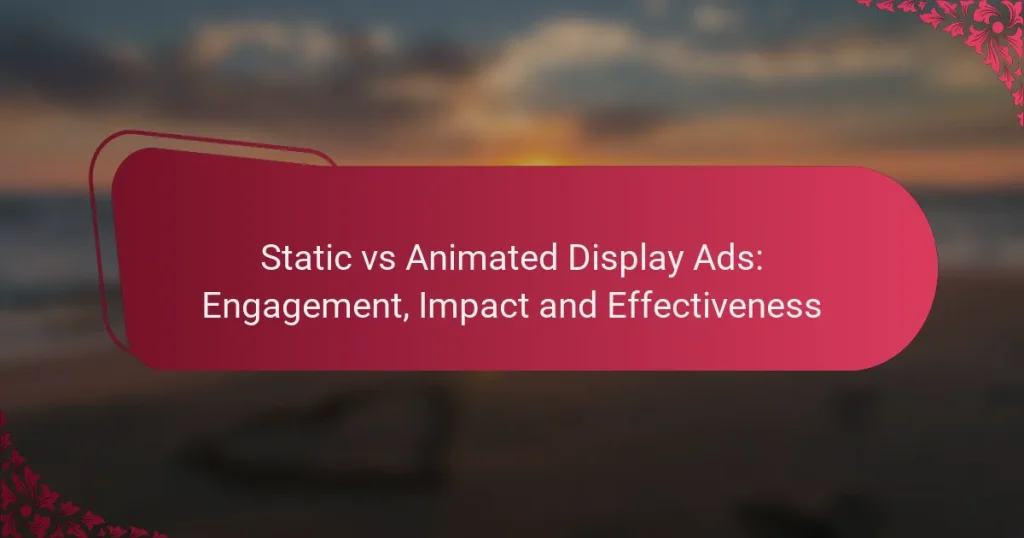Static and animated display ads play crucial roles in digital marketing, each offering unique advantages. While static ads are cost-effective and simple to produce, animated ads often drive higher engagement and better brand recall. The decision between the two should align with your campaign objectives and budget, as animated ads typically excel in capturing audience attention and conveying messages more dynamically.

How do static display ads compare to animated display ads in Estonia?
In Estonia, static display ads generally have lower production costs and are easier to create, while animated display ads tend to achieve higher engagement and can convey more information effectively. Choosing between the two depends on your campaign goals and budget considerations.
Static ads have lower production costs
Static display ads typically require less investment in terms of design and production compared to animated ads. The absence of motion graphics and complex animations means that businesses can save on both time and resources.
For small to medium-sized enterprises in Estonia, opting for static ads can be a cost-effective strategy, especially when working with limited marketing budgets. This allows for more flexibility in allocating funds to other areas of the campaign.
Animated ads typically yield higher engagement
Animated display ads often capture more attention and can lead to higher engagement rates. The dynamic nature of these ads tends to draw viewers in, making them more likely to interact with the content.
In Estonia, studies suggest that animated ads can increase click-through rates significantly compared to static ads. This makes them a valuable option for brands looking to enhance their visibility and user interaction.
Static ads are easier to create
Creating static display ads is generally a straightforward process, requiring basic graphic design skills. This simplicity allows marketers to quickly produce ads without extensive training or specialized software.
For businesses that need to launch campaigns rapidly, static ads can be designed and deployed in a matter of days. This agility can be crucial in responding to market trends or seasonal promotions.
Animated ads can convey more information
Animated display ads have the advantage of presenting more complex messages through visual storytelling. They can incorporate multiple elements, such as text, images, and sound, to communicate ideas effectively.
This capability allows brands in Estonia to showcase products or services in a more engaging manner, potentially leading to better brand recall. However, it’s essential to ensure that the animation does not overwhelm the viewer, maintaining clarity and focus on the key message.

What is the impact of static and animated ads on user engagement?
Static and animated ads significantly influence user engagement, with animated ads generally leading to higher interaction rates. The choice between the two can affect click-through rates, brand recall, and overall effectiveness in capturing audience attention.
Animated ads increase click-through rates
Animated ads tend to attract more attention, leading to higher click-through rates compared to static ads. This is primarily due to their dynamic nature, which can create a sense of movement and urgency that engages viewers more effectively.
For instance, studies suggest that animated ads can improve click-through rates by a notable margin, often in the range of 20-50% over static options. However, it’s essential to balance animation with clarity to avoid overwhelming the viewer.
Static ads provide clear messaging
Static ads excel in delivering straightforward messages without distractions, making them ideal for clear communication. Their simplicity allows for quick comprehension, which is crucial when targeting audiences with specific information.
For example, a well-designed static ad can effectively convey a promotional offer or brand message in a single glance, making it easier for users to understand the value proposition. This clarity can lead to better retention of information, especially in environments where users are quickly scanning content.

Which type of display ad is more effective for brand awareness?
Animated display ads are generally more effective for brand awareness than static ads due to their ability to capture attention and convey messages dynamically. The movement in animated ads can enhance engagement and recall, making them a popular choice for brands looking to make a lasting impression.
Animated ads enhance brand recall
Animated ads leverage motion to draw viewers in, which can significantly improve brand recall. Studies suggest that ads with movement can increase viewer engagement by capturing attention more effectively than static images. For example, a well-designed animated ad can highlight key features of a product or service in a matter of seconds, making it easier for consumers to remember the brand.
However, it’s essential to balance creativity with clarity. Overly complex animations can confuse viewers, leading to decreased effectiveness. Aim for animations that are simple yet impactful, focusing on core messages that resonate with your target audience.
Static ads maintain brand consistency
Static ads are beneficial for maintaining brand consistency, as they allow for a uniform presentation of brand elements, such as logos, colors, and fonts. This consistency helps reinforce brand identity and can build trust with consumers over time. For instance, a brand that uses the same static ad across various platforms can create a cohesive image that is easily recognizable.
While static ads may not capture attention as effectively as animated ones, they can be strategically placed in environments where consumers are already engaged, such as on social media feeds or websites. To maximize effectiveness, ensure that the design aligns with your overall branding strategy and resonates with your audience’s preferences.

What are the key factors to consider when choosing between static and animated ads?
When choosing between static and animated ads, consider factors such as audience engagement, budget, and the intended message. Each format has distinct advantages that can significantly impact effectiveness and viewer response.
Target audience preferences
Understanding your target audience’s preferences is crucial in deciding between static and animated ads. Some demographics may respond better to dynamic content, while others might prefer straightforward, static visuals. For instance, younger audiences often engage more with animated ads that capture attention quickly.
Conducting surveys or analyzing past campaign performance can provide insights into what resonates with your audience. Tailoring your ad format to these preferences can enhance engagement and improve conversion rates.
Advertising budget constraints
Budget constraints play a significant role in the choice between static and animated ads. Animated ads typically require higher production costs due to the need for skilled designers and animators, while static ads are generally more cost-effective to produce. If your budget is limited, static ads might be the better option to maintain quality without overspending.
However, consider the potential return on investment. If animated ads can significantly boost engagement and conversions, the higher upfront costs may be justified. Evaluate your budget against the expected performance of each ad type to make an informed decision.

How do performance metrics differ between static and animated display ads?
Performance metrics for static and animated display ads vary significantly, impacting engagement and effectiveness. Animated ads typically attract more user interaction, while static ads may lead to lower bounce rates.
Animated ads show higher engagement metrics
Animated display ads generally achieve higher engagement metrics compared to their static counterparts. This is largely due to their dynamic nature, which captures attention more effectively. For instance, studies suggest that animated ads can increase click-through rates by a notable margin, often exceeding 50% compared to static ads.
When designing animated ads, consider using eye-catching visuals and concise messaging to maintain viewer interest. However, avoid overly complex animations that may distract or confuse the audience.
Static ads have lower bounce rates
Static display ads tend to have lower bounce rates, indicating that users are more likely to stay on the page after viewing these ads. This can be attributed to the straightforward presentation of information without the distractions of movement. A well-placed static ad can effectively communicate a message without overwhelming the viewer.
To maximize the effectiveness of static ads, focus on clear calls to action and relevant imagery. Ensure that the ad aligns well with the surrounding content to enhance user retention and minimize bounce rates.

What are the best practices for creating effective static and animated display ads?
Effective static and animated display ads should capture attention quickly and convey a clear message. Best practices include focusing on visual appeal, concise messaging, and strong calls-to-action to drive user engagement.
Focus on clear calls-to-action
Clear calls-to-action (CTAs) are essential for guiding users toward the desired action, whether it’s making a purchase or signing up for a newsletter. A strong CTA should be prominently placed and use action-oriented language, such as “Shop Now” or “Learn More.”
Consider using contrasting colors for your CTA buttons to make them stand out. Additionally, limit the number of CTAs in a single ad to avoid overwhelming the viewer; one or two effective CTAs are usually sufficient.
Test different CTA phrases and placements to see which ones yield the best engagement rates. A/B testing can help identify the most effective options, allowing you to refine your approach based on actual user behavior.

